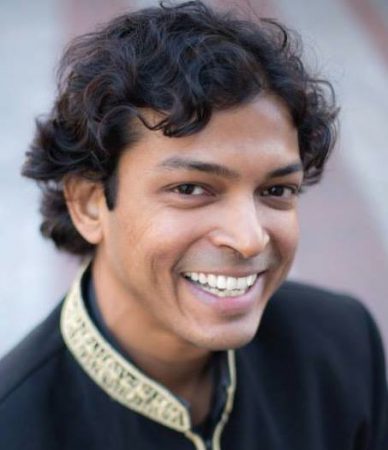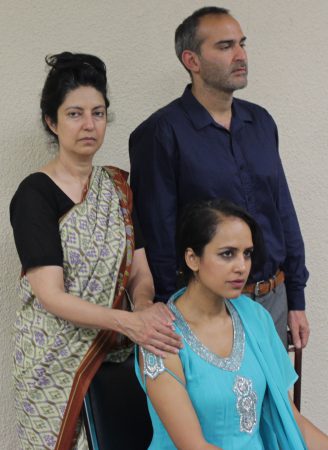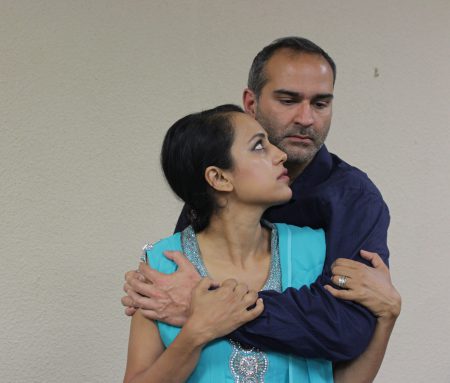Rohit Chokhani i s a go-getter. Charting his own path as a theatre director and producer, he strives to make space for South Asian artists through his initiative, Project SAT (South Asian Theatre), where they can receive support and mentorship in the theatre arts.
s a go-getter. Charting his own path as a theatre director and producer, he strives to make space for South Asian artists through his initiative, Project SAT (South Asian Theatre), where they can receive support and mentorship in the theatre arts.
With the premiere of Anosh Irani’s Bombay Black at the Vancouver Fringe Festival, we spoke to the 2017 Jessie Award-winning director about his experiences in Mumbai and Canada, his transition from computer science in theatre, and being the first Mumbai-born director of Indian descent to direct Bombay Black.
❇︎
Karla Comanda: What was your experience in the theatre community in Mumbai, and how does this compare to your experience in Vancouver?
Rohit Chokhani: I left Mumbai fourteen years ago, roughly coming on fifteen. I actually first went to the US, then back to India. I left India and moved to Canada seven years ago, but that’s after seven years of education in the US.
My professional [theatre] experience has been more in the Western world. As a kid, my exposure to the arts was as something that I did on the side. A lot of my [current] work focuses on the cultural barriers that artists of colour face in the mainstream theatre community, but also within our community. One of the things that I grew up with was a very stereotypical South Asian upbringing where the societal pressure and philosophy was to be a doctor, engineer… all those highly-paid professional jobs, because there’s nothing for the arts.
My parents are really good at encouraging me, and I’m grateful for that. It all changed for me when I moved out West because I saw a way to take what I was doing as extracurricular, saw a lot of potential in myself, and had that belief to be able to work that into a career. And here we are, a few years later, and I’m working full-time in the arts.
KC: It’s interesting that you say that most of your experience has been in the Western world, because this is something I can relate to as someone who moved from the Philippines to Canada, and having this longing to more closely connect with my country’s cultural traditions. With Project SAT, what was the catalyst for you?
RC: In Canada, given such high immigrant population, and also South Asians being one of the largest visible minorities… a lot of mixed-race artists, immigrant artists, indigenous artists… we all face the challenges and the barriers within our culture, but then there’s also barriers in the mainstream where most of the artistic excellence or so-called “good products” in the arts are coming out of Eurocentric practices, even though there are lots of other ways of creating art. That was the impetus and personal inspiration in wanting to create something where people have the freedom to explore their own artistry and didn’t have to face systemic barriers that exist currently in the professional arts world.
Given my background, I wanted to create a platform where there was support for future generations of South Asian artists. I didn’t want them to go through what I’ve gone through for years in creating a space for myself. I know that a lot of people are going through that, and I don’t want that to happen for our emerging artists. I want them to have more fluidity in their processes and more culturally-specific freedom to do work that they want to do.
KC: I completely understand the motivations for this project, especially where racialized and oppressed artists of colour feel that their work is not recognized because of these barriers. How important is it to have mentorships that are tailored to the cultural backgrounds and traditions of marginalized groups?
RC: I think it’s very important to have mentors. I had many mentors both from within the culture and from outside the culture. In the artists’ community in 2017, there is far more space for me now than what it was like 30 years ago, 40 years ago.
Rahul Varma has been a big champion for me all these years. He was the first one who came and created a company called Teesri Duniya (Third World Theatre). His work is very political from the South Asian perspective, but also about many other cultures. He’s a really great writer, and is a playwright for his own company. What he had to face when he immigrated here… I cannot even imagine what I would’ve been able to do under those circumstances as a first-generation immigrant artist. But we move forward, and there is still a lot of work to do.
These folks have been really generous to me. They’ve passed on the torch. They continue doing their work, and they’ve supported us to light it. There needs to be something more formalized so we can do it in more quantities. From the mainstream perspective, when people talk about South Asian artists in their world, they can only count a few. But in my world, I have hundreds. And that needs to change.

Poster for Bombay Black
KC: The mentorship seems to be addressing subjects beyond craft, including grant writing and pitching projects. Was there any program of this sort when you were starting out your theatre career in Canada?
RC: I never took formal theatre training or any other program; that does not mean I don’t value what’s out there. I am a go-getter. I design programs on my own terms through professional development grants or through individual relationships, and train myself in various areas.
I put myself in relationships and partnerships and organizations where I could learn how things are done despite it being Eurocentric. Once I understood the world and the picture and how to raise money and all of that, in parallel, I was training myself in culturally-specific work because I didn’t have any formal training there. I started bringing in artists that I was interested in, and then by observing, I started learning. And I still am.
I feel like there are a few of us who have been successful now doing this, myself included, but we had to chart out our own paths without formalized training programs. I know a lot of South Asians who go to theatre programs like UBC and Studio 58, and those are valuable for people who are open to doing culturally-specific work as well as Eurocentric work, but if there is someone who is not interested in going through that kind of model, there should be something else like this that exists formally.
KC: I’m surprised to learn about your background in computer science. How did you make the leap from that to being a theatre artist?
RC: Theatre happened by chance. The art was always there… even though I was a computer geek as a kid, I was designing and taking animation classes on the side. I just didn’t have the belief to go against societal and familial pressure as a teenager. But as I became stronger as an adult, it was more of a mental and philosophical shift. Art in my life had already existed because my parents were very supportive of us performing and dancing as kids then.
I think the shift really happened because of my management skills and my ability to bring groups of people together and hold space for different perspectives. Even though I was traditionally very knowledgeable in the skill of computer science… I wanted to get out of there soon and get into the arts, so I started applying for management positions in video game companies and one such company picked me up and I went from being an intern to producer in a very short period of time. It was mainly because of my leadership and management skills.
Once you’re in there, you just learn everything through your experience and you understand what the process is. And I personally think that once you understand how to produce in any one of the fields, whether it’s film, video games, or theatre, I think the kind of decision-making and problem solving and critical skills that you need are kind of the same, you just need industry-specific knowledge. I immigrated to Canada, and through friends, I landed in theatre and after a few projects of my own, I was able to get the more discipline-specific knowledge of theatre. The rest is history.
KC: Are there any similarities with your approach to video games and directing theatre?
RC: I’m a very visual guy. [Bombay Black has a] very interesting script because this is about a blind man wanting to hire an exotic dancer. With a blind man, you take away all the visuals. The whole concept of why would a blind man want go to an exotic dancer was a very interesting story.
Yeah, I think there’s a commonality there. Even when I was in video games, I was dealing with visuals, and now in theatre, I’m still drawn to material that is visual. When I say visual, it does not always have to be the visuals that you see. In Bombay Black, a lot of visual things are going to be imagined in our heads. This play has been done many times before, but my re-imagined take has a couple of things that I believe are unique to the way I am wanting to do this production.
One of them is that I want the audience to feel what it’s like to be blind. Some portions of the script will be interpreted where the audience will be blind. The second thing is that Bombay Black has been produced many times, of course, in Canada, India… but in Canada, it’s never been directed by someone who is of Indian descent and Mumbai-born. I am both of those, so I think just by those facts, there are some new things that will come out of this re-imagination of Bombay Black.

Photo credit: Zahida Rahemtulla
KC: Could you clarify that? The fact that you would be the first Indian director for Bombay Black is a shock to me.
RC: I think it’s a disturbing fact and that kind of ties in to what I’m trying to do with Project SAT. I think the way directors get selected is a conversation on its own, but it kind of goes back to the sort of path that we were talking about earlier, where it is very Eurocentric. It becomes clearer that there is no space. First, how many South Asian plays get produced? Second, how many South Asian actors get the opportunity to be in plays? The third is, even if it is South Asian content, how much of it is actually led by producers who are South Asian, or led by an artistic vision which comes from a director who’s South Asian? All of that is super-marginalized, and it doesn’t exist. It’s pretty daunting for someone to take on that.
In terms of what needs to happen in the theatre community at large, I think that’s the shift we need to see. Project SAT wants to facilitate that, and I think it’s great for me to get that opportunity and for Anosh Irani to trust in me, to give me an opportunity to direct a script that is going to be well-produced. It’s really a favour from him to give me the rights to direct this. I’m really honoured and I look forward to delivering that vision.
KC: How did you come to direct Bombay Black?
RC: [Anosh Irani and I] both happened to be in Mumbai at the same time a couple of years ago, and we met there for coffee. We were close to the world where all this takes place. That time, there was nothing specific about what we were going to do. We spoke of all the things he has done: Bombay Black, Matka King, and a few upcoming things he was writing.
Anosh was one of the first ones who came on board [with Project SAT]. He did a Playwriting 101 workshop last year and it was a huge hit. We are working again on another workshop, this time for a slightly more advanced level where people have a script or project in progress. It was not so far-off for us to start talking about how to bring his work to the work that I do. One of things I asked him was, can you let me direct Bombay Black?
I think I have a unique perspective given that we are from there, and have some connections over how we saw theatre in the country, and also how we saw Bombay. We have a lot of similarities. We both came here – in his case, he transitioned from an advertising background into writing; I transitioned from a computer science background into producing and directing. I think he really loved the idea because I had a unique take on it.
KC: How has your experience been directing Bombay Black so far?
RC: It’s been a very eye-opening process. Not often is a play written with a character blind. It does involve rethinking some things in order to portray it correctly. We’ve had a lot of interesting people come on board [during the auditioning process]. It’s always interesting to see the kind of people coming and their unique take on various things.
It’s my first time directing at the Fringe, but I’ve been involved with two productions before in the Fringe, so I’m pretty familiar with that process. And both those productions were pretty well-received and well-awarded at the Fringe. This is a new hat I’m wearing as a director.
That transition that we spoke about where I came as an immigrant and didn’t have that many opportunities to start with despite my background in video games… Fringe was a platform that launched me into the theatre world. That time, it launched me as a producer. Two years later, I come back as a very established producer, but also launching myself as a director now.

Photo credit: Zahida Rahemtulla
KC: Going back to Project SAT, what do you want to see it become? What are your goals for it, ultimately?
RC: Besides the formal goal of creating a network and having ongoing training for emerging South Asian artists, I would want it to expand. We already have all of our workshops [and they] have the option for participants to request any kind of access to the language that they would want. So in the past, we have had ASL (American Sign Language) for participants. Although it’s South Asian, we don’t want to keep it just under the South Asian spectrum. If there are other people outside of South Asian culture who have had similar experiences, [they] would be perfect for Project SAT.
My long term vision would be that it becomes sort of a huge incubator for new shows, and new artists, and there would be an event that happens annually where all of us come together and discuss what should be the next steps in moving the art form and the culturally-specific practices forward.
KC: What’s next for Rohit Chokhani?
RC: My plate is pretty full at the moment. Immediately after Bombay Black is done, my partner Ashley Rose and I are writing a project that’s based on intercultural dating and our specific experience, and that is getting professional reading at the Prismatic Arts Festival in Nova Scotia. After that, I will curate the Diwali Festival. Because the whole theme has been around Bombay, my parents [will come to Canada]. This Diwali is when they’ll get to see one of my productions for the first time, so it’s special.
See Bombay Black at the Vancouver Fringe Festival from September 9-16 at Vancity Culture Lab. Tickets are available on the Vancouver Fringe Festival website. Schedules may vary.